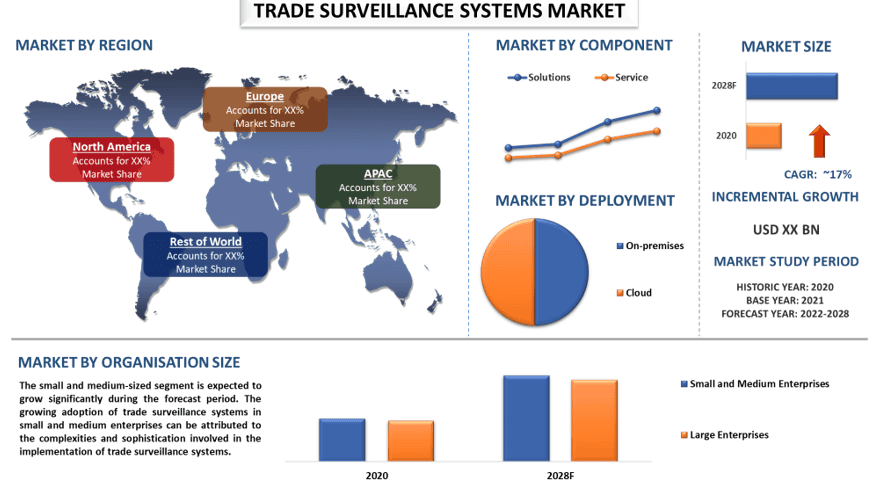- Home
- About Us
- Industry
- Services
- Reading
- Contact Us
Trade Surveillance System Market: Current Analysis and Forecast (2022-2028)
Emphasis on Component (Solutions and Services); Deployment (On-Premises and Cloud) Organization Size (Small & Medium Enterprises, and Large Enterprises); and Region/Country.

The Global Trade Surveillance System Market is anticipated to grow with an elevated CAGR of around 17% over the forecast period (2022-2028). The trade surveillance systems offer various solutions for an organization such as detecting activities for market manipulation, fraud, behavioral patterning, and more across all asset classes and all products, thereby ensuring the prevention and investigation of abusive, manipulative, or illegal trading practices in the securities markets. The growing adoption of trade surveillance systems can be attributed to the growing trade malpractices. Furthermore, the growing need to monitor trade activities in financial institutions, and the rising demand to meet trade and compliance regulations are the reasons for the surge in the adoption of trade surveillance systems market. Moreover, with time trading is becoming more complex each day, with an increasing number of transactions that are required to be monitored/observed. For instance, according to Thomson Reuters the total cost of financial crime amounts to more than USD 1.45 trillion, 3.5% of the turnover globally; using trade surveillance systems makes monitoring complex transactions simpler.
Insights Presented in the Report
“Amongst component, solutions segment holds the major share”
Based on component, the market is segmented into solutions and services. The solutions segment is expected to grow significantly during the forecast period, the growing adoption of the trade surveillance systems can be attributed to the constantly increasing number of transactions across the globe. Furthermore, trade surveillance solutions provide full control to the organization, which is necessary as trade surveillance also helps organizations deal with the government regulatory bodies.
“Amongst deployment, on-premises segment holds the major share”
Based on deployment, the market is segmented into on-premises and cloud. The on-premises segment is expected to achieve a significant CAGR during the forecast period. Applications deployed on the on-premise infrastructure are more secure and reliable compared to cloud infrastructure.
“Amongst organization size, small and medium segment holds the major share”
Based on organization size, the market is segmented into large, small, and medium organizations. The small and medium organizations are expected to gain significant prominence during the forecast period. The growing adoption of trade surveillance systems in small and medium organizations can be attributed to the increasing number of regulations and the complexities involved.
“Europe represents one of the largest markets of trade surveillance system market”
For a better understanding of the market dynamics of the trade surveillance system market, a detailed analysis was conducted for different regions across the globe including North America (U.S, Canada, and the Rest of North America), Europe (Germany, France, Spain, United Kingdom, Italy, and Rest of Europe), Asia-Pacific (China, India, Australia, Japan, and Rest of APAC), Rest of World has been conducted. The European region is expected to grow significantly during the forecast period, the growth in the region can be attributed to the rising adoption and implementation of trade surveillance systems, and the presence of prominent players, furthermore, rising investment by the fintech companies and complexities of government regulations are the main reasons for the adoption of trade surveillance systems in the region.
Reasons to buy this report:
- The study includes market sizing and forecasting analysis validated by authenticated key industry experts
- The report presents a quick review of overall industry performance at one glance
- The report covers an in-depth analysis of prominent industry peers with a primary focus on key business financials, product portfolio, expansion strategies, and recent developments
- Detailed examination of drivers, restraints, key trends, and opportunities prevailing in the industry
- The study comprehensively covers the market across different segments
- Deep dive regional level analysis of the industryCustomization Options:
The global trade surveillance system market can further be customized as per the requirement or any other market segment. Besides this, UMI understands that you may have your own business needs, hence feel free to connect with us to get a report that completely suits your requirements.
Table of Content
Research Methodology for the Global Trade Surveillance System Market Analysis (2022-2028)
Analyzing the historical market, estimation of the current market, and forecasting the future market of the global Trade surveillance system market were the three major steps undertaken to create and analyze the adoption of the Trade surveillance system market in major regions globally. Exhaustive secondary research was conducted to collect the historical market numbers and estimate the current market size. Secondly, to validate these insights, numerous findings and assumptions were taken into consideration. Moreover, exhaustive primary interviews were also conducted, with industry experts across the value chain of the global Trade surveillance system market. Post assumption and validation of market numbers through primary interviews, we employed a top-down/bottom-up approach to forecasting the complete market size. Thereafter, market breakdown and data triangulation methods were adopted to estimate and analyze the market size of segments and sub-segments the industry pertains to. Detailed methodology is explained below:
Analysis of Historical Market Size
Step 1: In-Depth Study of Secondary Sources:
Detail secondary study was conducted to obtain the historical market size of the trade surveillance system market through company internal sources such as annual report & financial statements, performance presentations, press releases, etc., and external sources including journals, news & articles, government publications, competitor publications, sector reports, third-party database, and other credible publications.
Step 2: Market Segmentation:
After obtaining the historical market size of the trade surveillance system market, we conducted a detailed secondary analysis to gather historical market insights and share for different segments & sub-segments for major regions. Major segments are included in the report as component, deployment, and organization size. Further country-level analyses were conducted to evaluate the overall adoption of the trade surveillance system market across the globe.
Step 3: Factor Analysis:
After acquiring the historical market size of different segments and sub-segments, we conducted a detailed factor analysis to estimate the current market size of the trade surveillance system market. Further, we conducted factor analysis using dependent and independent variables such as component, deployment, and organization size. A thorough analysis was conducted for demand and supply-side scenarios considering top partnerships, mergers and acquisitions, business expansion, and product launches in the trade surveillance system market sector across the globe.
Current Market Size Estimate & Forecast
Current Market Sizing: Based on actionable insights from the above 3 steps, we arrived at the current market size, key players in the trade surveillance system market, and market shares of the segments. All the required percentage shares split, and market breakdowns were determined using the above-mentioned secondary approach and were verified through primary interviews.
Estimation & Forecasting: For market estimation and forecast, weights were assigned to different factors including drivers & trends, restraints, and opportunities available for the stakeholders. After analyzing these factors, relevant forecasting techniques i.e., top-down/bottom-up approach were applied to arrive at the market forecast about 2028 for different segments and subsegments across the major markets globally. The research methodology adopted to estimate the market size encompasses:
- The industry’s market size, in terms of value (US$) and the adoption rate of trade surveillance system market across the major markets domestically
- All percentage shares, splits, and breakdowns of market segments and sub-segments
- Key players in the trade surveillance system market in terms of products offered. Also, the growth strategies adopted by these players to compete in the fast-growing market
Market Size and Share Validation
Primary Research: In-depth interviews were conducted with the Key Opinion Leaders (KOLs) including Top Level Executives (CXO/VPs, Sales Head, Marketing Head, Operational Head, Regional Head, Country Head, etc.) across major regions. Primary research findings were then summarized, and statistical analysis was performed to prove the stated hypothesis. Inputs from primary research were consolidated with secondary findings, hence turning information into actionable insights.
Split of Primary Participants in Different Regions

Market Engineering
Data triangulation technique was employed to complete the overall market estimation and to arrive at precise statistical numbers of each segment and sub-segment of the trade surveillance system market. Data was split into several segments & sub-segments post studying various parameters and trends in the areas as component, deployment, and organization size. of the trade surveillance system market.
The main objective of the trade surveillance system market Study
The current & future market trends of the trade surveillance system market were pinpointed in the study. Investors can gain strategic insights to base their discretion for investments on the qualitative and quantitative analysis performed in the study. Current and future market trends determined the overall attractiveness of the market at a regional level, providing a platform for the industrial participant to exploit the untapped market to benefit as a first-mover advantage. Other quantitative goals of the studies include:
- Analyze the current and forecast market size of the trade surveillance system market in terms of value (US$). Also, analyze the current and forecast market size of different segments and sub-segments
- Segments in the study include areas of component, deployment, and organization size.
- Define and analysis of the regulatory framework for the trade surveillance system market industry
- Analyze the value chain involved with the presence of various intermediaries, along with analyzing customer and competitor behaviors of the industry
- Analyze the current and forecast market size of the trade surveillance system market for the major region
- Major regions studied in the report include North America, Europe, Asia-Pacific, and Rest of the world
- Company profiles of the trade surveillance system market and the growth strategies adopted by the market players to sustain in the fast-growing market
- Deep dive regional level analysis of the industry
Related Reports
Customers who bought this item also bought










